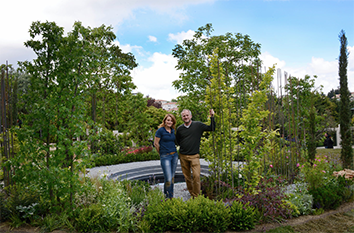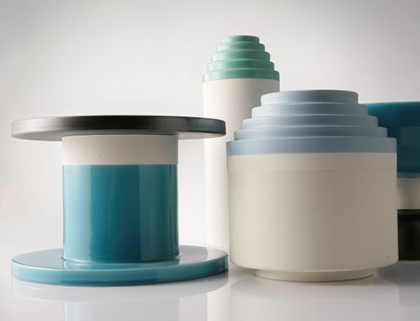February 2017
Box mentality

A broader approach to any design project can achieve a property’s full potential. Emanuela Alladio of Alladio Sims Garden Landscape Design Limited advocates planning outdoor spaces right from the beginning of any project.
When planning a new extension or build, we tend to think inside the box. We visualise the house as the main box, sitting somewhat alone on a piece of landscape, and then divide this empty box into separate rooms, each with its own very specific function to fulfil – each a smaller, yet still empty, box (furnishings are often brought into action at a later stage).
Once the main box is finished, we stop to wonder how the box relates to the space around it. Only at the end do we think of ways to soften the building and make it sit more naturally within the outside space. The result is that often the finished box doesn’t connect with the neighbourhood or the wider landscape, and the inside/outside flow is seriously compromised and its potential lost.
Yet when we admire images of houses and gardens conceived with an integrated approach, we are in awe. So why consider the relation between house and landscape as an afterthought? Wouldn’t it be better if someone was in charge of thinking outside the box from the very beginning of a project?
We could do so much more if we engaged the building with its surrounds from the very beginning. If, at the early planning stage, client, architects, garden designer and interior designer all sat at the same table the result would mean much fewer lost opportunities, well-integrated solutions and useful economies of scale.
We hire architects to create forms from interconnected spaces, focusing on concepts such as flow and aesthetic, we hire interior designers to introduce the right mood and texture to each and every one of these spaces. All our energy is spent worrying about what happens inside – floors, furniture, curtains, light fittings, kitchens and bathrooms – forgetting that this beautiful flow will stop as soon as those brand new bi-fold doors open – and we are faced with an empty and alien back garden.
Yet the solution is out there. Bringing in a skilled garden designer can continue the dialogue outside. A skilled designer will absorb information from all sources and develop the outside space to extend the link with the house. Your brilliant, new, glass-clad, sleek kitchen living area will no longer open to an uninspiring and empty back garden. You will discover a new world of potential and create a stunning outdoor room.
Some tricks are simple: choose the same porcelain tiles installed in the kitchen for the patio area – in a different finish to add slip resistance outside – to achieve that instant, seamless, indoor/outdoor transition. Make the most of the expanse of glass walls in your new extension by controlling the views out, creating new ones, adding light and water for a touch of drama.
Of course, just like a good architect or interior designer, a great garden designer will guide you through this process, looking at the ‘outside box’ and dividing it up into a series of meaningful layers each with a different function: privacy, drama, entertaining, framing the view etc. And the difference will be in the small details – identifying the best aspect for dining or enjoying a swim or a view, making the space feel much bigger and more inviting thanks to directional paving or the right materials and plant palettes, choosing the best plants for the site given the local soil, drainage and exposure to the elements. Once this process is complete, the indoor/outdoor flow will be seamless.
Despite this enormous potential, so often garden designers are called to ‘intervene’ right at the end of the renovation, new build or extension, missing out on some earlier opportunities. Considering the outer environment can bring so many tangible advantages to any development, for example, by making the most of an existing level, framing a borrowed view from the landscape and creating a positive link between the building and its surrounds. This can be easily achieved if the garden designer is engaged from the beginning as a three-way conversation with the architect and client. It would often mean saving on costs too as later ‘interventions’ are minimised.
This holistic approach to an extension or a new build is already very established across the ocean and is being adopted here too, producing some amazing results. Next time we admire a stunning new build if we ask ourselves why our eyes are so drawn by what they see it will no doubt be the very unique connection that the building has managed to establish with its surrounds, the creative use of local materials, the effective and functional use of space, the clever yet understated details. This very elegant product will be the result of clever thinking outside the box.

Profile: Alladio Sims
Alladio Sims Garden Landscape Design Ltd was established in 2015 after Jon Sims and Emanuela Alladio collaborated on a Silver Gilt winning show garden at RHS Hampton Court Palace Flower Show. The two directors continue their collaborative approach throughout their practice with Jon’s background in interior architecture giving distinctive spaces and Emanuela’s passion for plants and photographic eye adding great texture and contrast.
essence info
Alladio Sims Garden Landscape Design Limited
Unit C Willow House, Dragonfly Place, London SE4 2FJ
Website: www.alladiosims.co.uk
Email: hello@alladiosims.co.uk
Tradition and cutting edge

Internationally known for its excellence and creative spirit, it’s the passion and skill of the hands of those who work the ceramics that is at the heart of Bitossi Ceramiche. Jane Pople takes a close look at the renowned brand.
Combining the traditional art of ceramic making with cutting edge style has been the aim of Italian brand Bitossi Ceramiche since the early 1900s. This prestigious brand’s long history is founded on a profound understanding of the material, and its natural propensity for experimentation. The brand’s roots stem from the productive ceramic tradition that existed in Montelupo Fiorentino from the 1500s. Tracing its beginning in ceramic production to as early as 1871, the Bitossi family business has centuries of expertise.
Guido Bitossi was heir to this long ceramic tradition and established the ‘Manifattura Maioliche Artistiche’ in 1921, a centre featuring typical local craft works. Thanks to the art direction of Aldo Londi, traditional production methods and procedures were renewed, and really this was the beginning of Bitossi Ceramiche as we now know it today.
Aldo’s meeting with the now iconic architect Ettore Sottass marked a significant turning point for the brand and this important encounter led to a close collaboration with Londi for many years. Together, this visionary duo created many successful designs and continued to expand their skills and creative genius. Bitossi Ceramiche is still in the original factory today, and it is still the go-to brand for leading designers fascinated by the historical value of the company, by craft production and the creation of unique collections.
Since 1871, the Bitossi family has collected over 7,000 historical works, documents and material related to artistic ceramic production. This vast archive is an attempt to preserve and valorise the historic memory that the family has been collecting over the years. The Archivio Industriale Bitossi (Bitossi Industrial Archive) spreads over seven rooms in the historic Colorificio building near to the factory. This collection also includes important ceramics and documents from other factories, in particular those from the Florentine ceramics area. In order to safeguard the heritage of this important area and its work in ceramics, the Vittoriano Bitossi Foundation became involved in 2010. One of the Foundation’s statutory purposes is precisely: “the preservation and valorisation of the history of artistic ceramics in the Florentine territory.”
The Foundation’s main sponsor is the Colorobbia Group and its chief purpose is the enhancement and dissemination of the ceramic culture, historical research and scientific research. It promotes cultural initiatives involving modern and contemporary art, also on the international scene. In addition, it performs supporting activities in the health sector in ceramics districts where the Group’s companies are located.
In 2003, the MAIB – Museo Artistico Industriale Bitossi (Bitossi Industrial Art Museum) – was opened to house this collection. Temporary exhibitions offer various insights into production periods and styles linked to the talent of Aldo Londi, the company's historical art director, and also into design. The museum and archive are run by the Foundation, a direct offshoot of the Bitossi family.
The Bitossi Artistic Industrial Museum opened in 2003, and is world renowned as an industrial museum that exhibits artistic ceramics productions of the twentieth century, and in particular, from the mid nineteen-fifties up until the present time. It currently covers two rooms in a historic 1929 building, which was the first site of the Bitossi factory.
The Museum organises temporary thematic exhibitions mainly on the huge historical production heritage with displays of the factory's production. It also houses exhibitions of architects and designers who have worked with the company.
The Foundation, the Museum and the overall winning identity of Bitossi Ceramiche is thanks to unprecedented entrepreneurial skills developed throughout the years and constant research for the utmost quality in each and every product.
One of the strongest examples of Italian excellence, Bitossi Ceramiche’s business approach of focusing on craftsmanship has brought it to the attention of many outstanding designers who expressed in the medium of ceramic a special creativity well suited to the material, resulting in a number of timeless icons. One of the most renowned ranges from Bitossi Ceramiche is Aldo Londi’s Rimini Blu. These blue designs with ‘waived’ pattern continue to fascinate consumers across the world and there is a vast range of designs and sizes to choose from.
Another highlight from Bitossi Ceramiche’s contemporary offering is Karim Rashid’s range, Symbolik. Comprising numbered vases, totems and bowls, it has been inspired by the colourful Sottass totems and it introduces the language of signs, one of the main features of the Egyptian designer. Invest in authentic Italian craftsmanship and discover the world of Bitossi Ceramiche now available at Amara.
essence info
Bitossi Ceramiche is a new addition to the Amara brand portfolio.
Websites: www.bitossiceramiche.it, www.amara.com
This article first appeared in The Lux Pad, www.amara.com/luxpad